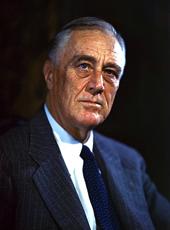My friends:
I cannot very well just say my friends of Montana, because in this group there are men and women of a great many States of the Union. That is one of the characteristics of this particular job. It is national in scope and it was undertaken with the idea that it would benefit the whole Nation. And it is going to do it.
It is a very delightful thing to form a mind picture of something from prints, drawings and figures, and then, a year later, come out and find that the project is just about twice as big and twice as fine as you thought it was.
I am tremendously impressed by the magnitude of this job. About three weeks ago the Secretary of War, who is with me today, met me down in the Canal Zone, Panama. We saw together one of the wonders of the world, the Gatun Dam. I had seen it many years ago when it was under construction. I did not believe then that anybody would build a dam bigger than the Gatun. I assure you it is a pigmy compared with Fort Peck.
Not only is this going to be, I am told, the largest earthwork dam in the world, but I believe also that in its construction we are going to do a very great amount of good for the elimination of unemployment. That means unemployment today and unemployment in the future. In so far as unemployment today goes, this type of dam probably uses more manpower, more hours of work in its completion, than concrete dams or other types.
It is also true, of course, that a very large proportion of the materials going into this dam come from other parts of the Union, some of them from Pittsburgh and New York and Birmingham, Alabama, and as far west as the Pacific Coast. There is the other feature—affording employment in the days to come.
I refer to the fact that, when this dam is completed, it is going to be an important factor in the navigation of the Missouri River. It is going to help to maintain a nine-foot channel. This channel will connect with the Mississippi. It will enable the wheat growers and farmers of the Northwest to get cheaper transportation rates from the middle of the country to the south and the east and to foreign countries.
Then, of course, there are other features: the power that will be generated; the effect on flood control and soil erosion. One of the things that makes me happiest is that downstream from this point they are going to be able to place under irrigation some 84,000 acres of land- land which today is not particularly fit for human habitation and which, when we get water on it, will be the means of support and honest livelihood for thousands of American families.
I understand that some people, seeking to misrepresent facts, have suggested that we are going out through the Northwest and saying to the families on marginal lands— families having a good deal of trouble making both ends meet—"You have to leave your homes tomorrow morning and get out."
Of course no person who thinks twice will believe silly tales of that kind.
It is a fact, however, and you and I know it, that there are many families in many States who are trying to make both ends meet without much success. It has been shown over a period of years that the land these families are using for agriculture ought not, for the best economic purposes, be used for agriculture.
Now, if those families want to go on farming that land and go deeper in the red every year, I take it it is their affair.
On the other hand, your Government believes in giving them a chance to go to better places—a voluntary chance. That is why this very broad national planning is seeking to provide farms where they will not have crop failures, where they will not be faced with starvation and where they may be able, I hope, to make not only both ends meet from the point of view of living, but also that they may come to own their farms free and clear of any debt.
Now people talk about the Fort Peck Dam as the fulfillment of a dream. It is only a small percentage of the whole dream covering all of the important watersheds of the Nation. One of those watersheds is what we call the watershed of the Missouri River, not only the main stem of the Missouri, but countless tributaries that run into it and countless other tributaries that run into those tributaries. Before American men and women get through with this job, we are going to make every ounce and every gallon of water that falls from the Heaven and the hills count before it makes its way down to the Gulf of Mexico.
It is because we have undertaken this gigantic task that will take us more than a generation to complete, because we have undertaken it now, and the people of the United States understand the objective of the idea, that I feel very certain we are going to carry it through to a successful completion.
That is one reason, my friends, the chief reason, that I am glad to be out in these parts today to see the work in its inception; to see the fine spirit of all the people who are engaged in the work. That is why, also, that I am very confident it is going to be carried through to the success and glory of the Nation.
Franklin D. Roosevelt, Remarks at Fort Peck Dam, Montana Online by Gerhard Peters and John T. Woolley, The American Presidency Project https://www.presidency.ucsb.edu/node/208562


